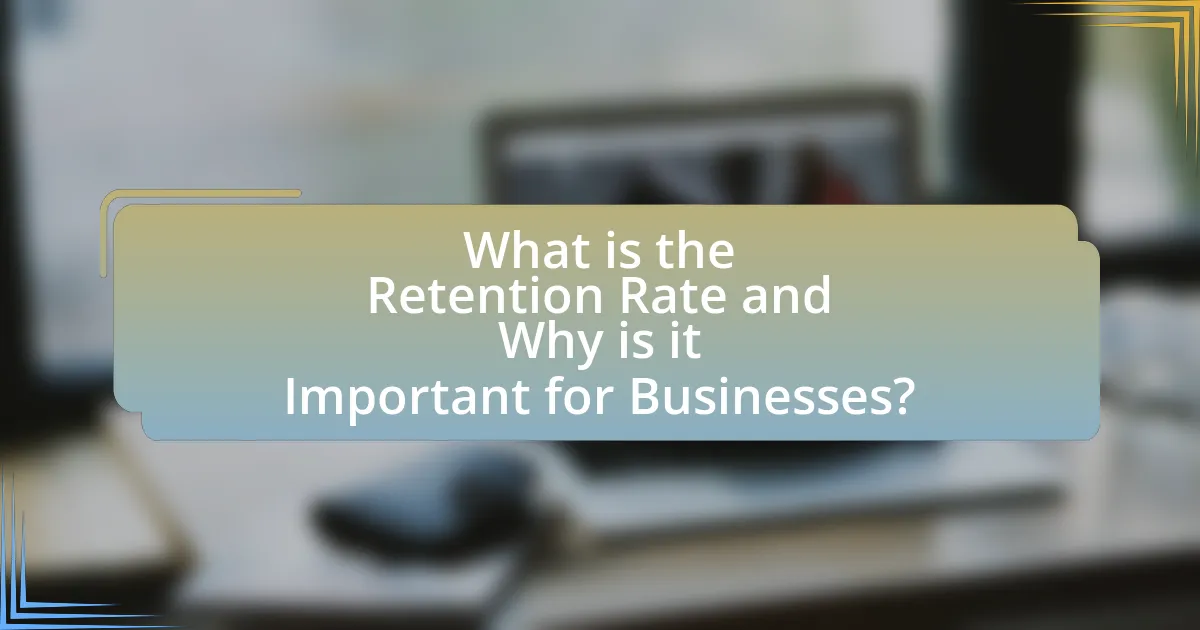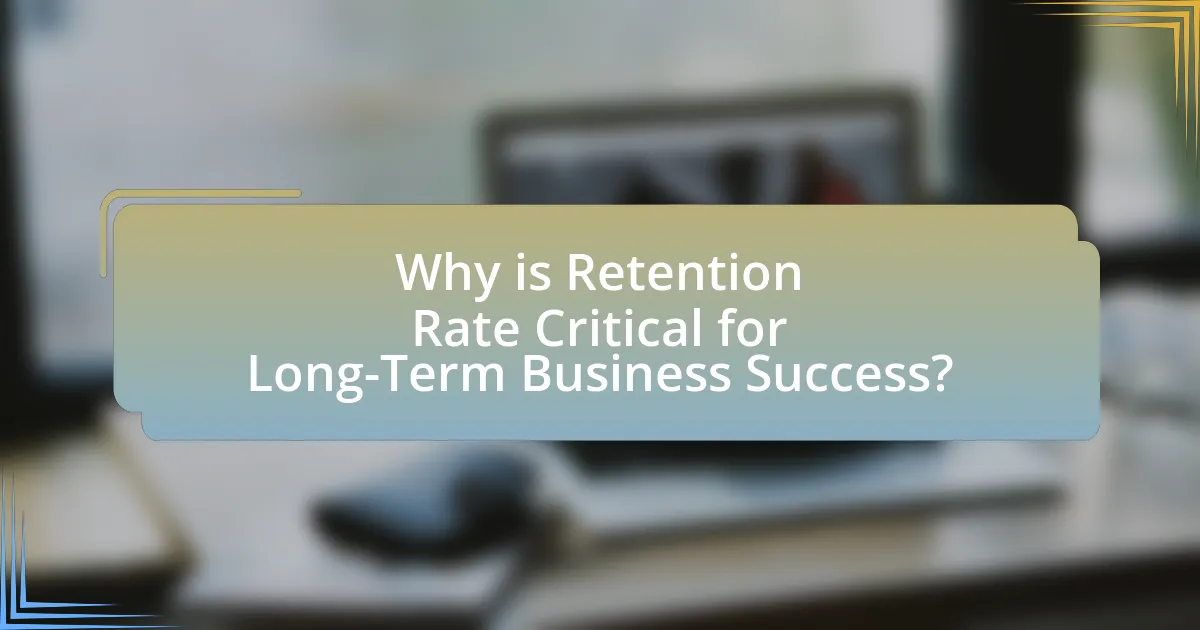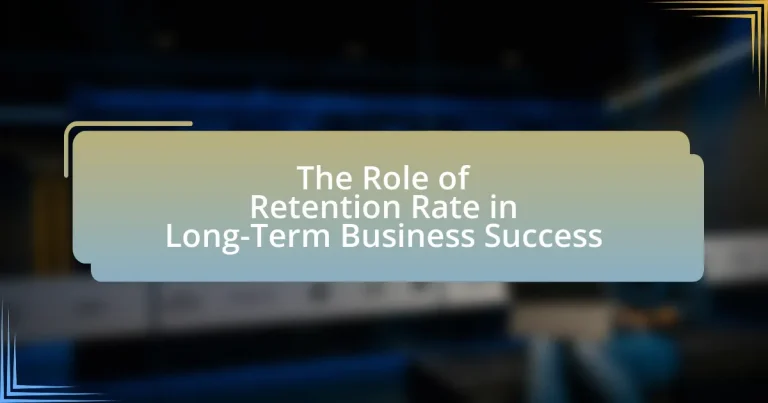Retention rate is a critical metric that measures the percentage of customers a business retains over a specific period, reflecting customer satisfaction and loyalty. This article explores the importance of retention rates for long-term business success, detailing how they are calculated and the various metrics used to assess them. It examines the factors influencing retention rates, such as customer satisfaction, product quality, and engagement strategies, while also highlighting the consequences of low retention rates on profitability and brand reputation. Additionally, the article discusses effective strategies and tools for improving retention rates, emphasizing their correlation with customer lifetime value and sustainable growth.

What is the Retention Rate and Why is it Important for Businesses?
Retention rate is the percentage of customers a business retains over a specific period, typically calculated by dividing the number of customers at the end of a period by the number of customers at the start of that period, then multiplying by 100. This metric is crucial for businesses because a high retention rate indicates customer satisfaction and loyalty, which can lead to increased revenue through repeat purchases and referrals. For instance, according to a study by Bain & Company, increasing customer retention rates by just 5% can boost profits by 25% to 95%. Therefore, understanding and improving retention rates is essential for long-term business success.
How is Retention Rate Calculated?
Retention rate is calculated by dividing the number of customers retained over a specific period by the number of customers at the start of that period, then multiplying the result by 100 to express it as a percentage. For example, if a business starts with 100 customers and retains 80 of them over a year, the retention rate would be (80/100) * 100, resulting in an 80% retention rate. This metric is crucial for assessing customer loyalty and the effectiveness of customer retention strategies.
What metrics are used to determine Retention Rate?
Retention Rate is determined using several key metrics, including Customer Retention Rate (CRR), Net Retention Rate (NRR), and cohort analysis. Customer Retention Rate measures the percentage of customers a business retains over a specific period, calculated by taking the number of customers at the end of a period minus new customers acquired during that period, divided by the number of customers at the start of the period. Net Retention Rate accounts for revenue lost from churned customers and revenue gained from upsells or expansions, providing a more comprehensive view of customer value retention. Cohort analysis tracks specific groups of customers over time to assess retention trends and behaviors, allowing businesses to identify patterns and improve strategies. These metrics collectively provide a clear picture of customer loyalty and business sustainability.
How does Retention Rate differ across industries?
Retention rates vary significantly across industries due to differing customer engagement levels and business models. For instance, the subscription-based software industry often sees retention rates exceeding 90%, as customers are more likely to remain loyal to services that provide ongoing value. In contrast, the retail industry typically experiences lower retention rates, averaging around 30% to 40%, as customers frequently switch brands based on price and availability. Additionally, the healthcare sector tends to have higher retention rates, often above 70%, due to the essential nature of services provided and the trust built between patients and providers. These variations highlight how industry characteristics influence customer loyalty and retention strategies.
What Factors Influence Retention Rate?
Retention rate is influenced by several key factors, including customer satisfaction, engagement, product quality, and effective communication. Customer satisfaction directly impacts retention, as studies show that a 5% increase in customer retention can lead to a 25% to 95% increase in profits. Engagement through personalized experiences fosters loyalty, while high product quality ensures customers remain satisfied and less likely to switch to competitors. Additionally, effective communication, such as timely support and feedback mechanisms, strengthens relationships and encourages repeat business. These factors collectively contribute to a higher retention rate, which is crucial for long-term business success.
How do customer satisfaction and experience impact Retention Rate?
Customer satisfaction and experience significantly enhance retention rates by fostering loyalty and encouraging repeat business. When customers are satisfied with their interactions and overall experience with a brand, they are more likely to continue purchasing from that brand, leading to higher retention rates. For instance, a study by Bain & Company found that increasing customer retention rates by just 5% can increase profits by 25% to 95%. This correlation underscores the importance of prioritizing customer satisfaction and experience as key drivers of retention.
What role does product quality play in Retention Rate?
Product quality significantly influences retention rate by directly affecting customer satisfaction and loyalty. High-quality products meet or exceed customer expectations, leading to repeat purchases and long-term relationships. According to a study by Bain & Company, increasing customer retention rates by just 5% can increase profits by 25% to 95%, highlighting the financial impact of maintaining a loyal customer base through quality offerings. Thus, businesses that prioritize product quality are more likely to achieve higher retention rates, contributing to sustained success.
What are the Consequences of Low Retention Rates?
Low retention rates lead to increased customer acquisition costs and decreased profitability. When businesses struggle to retain customers, they must invest more resources in marketing and sales to attract new clients, which can be significantly more expensive than maintaining existing relationships. According to a study by Bain & Company, increasing customer retention rates by just 5% can increase profits by 25% to 95%. Additionally, low retention rates can harm brand reputation, as dissatisfied customers are likely to share negative experiences, further deterring potential customers. This cycle can ultimately jeopardize long-term business success by undermining revenue stability and growth potential.
How does a low Retention Rate affect revenue and profitability?
A low retention rate negatively impacts revenue and profitability by increasing customer acquisition costs and reducing lifetime customer value. When businesses fail to retain customers, they must spend more on marketing and sales efforts to attract new customers, which can be significantly higher than the cost of retaining existing ones. For instance, studies indicate that acquiring a new customer can cost five to seven times more than retaining an existing one. Additionally, customers who remain loyal tend to spend more over time; a 5% increase in customer retention can lead to a profit increase of 25% to 95%, according to research by Bain & Company. Therefore, a low retention rate directly correlates with diminished revenue and profitability due to higher costs and lower customer spending.
What long-term impacts can low Retention Rates have on brand reputation?
Low retention rates can significantly damage brand reputation by creating a perception of unreliability and poor customer satisfaction. When customers frequently leave, it signals to potential clients that the brand fails to meet expectations, leading to negative word-of-mouth and diminished trust. Research indicates that acquiring new customers can cost five to twenty-five times more than retaining existing ones, highlighting the financial implications of low retention. Furthermore, a study by Bain & Company found that increasing customer retention rates by just 5% can lead to an increase in profits of 25% to 95%, underscoring the importance of maintaining a loyal customer base for a positive brand image.

How Can Businesses Improve Their Retention Rate?
Businesses can improve their retention rate by enhancing customer engagement through personalized communication and loyalty programs. Research indicates that companies with effective customer engagement strategies can see retention rates increase by up to 55%. Implementing feedback mechanisms, such as surveys and direct communication, allows businesses to understand customer needs and address issues promptly, further solidifying customer loyalty. Additionally, offering rewards for repeat purchases can incentivize customers to remain loyal, as evidenced by a study from the Harvard Business Review, which found that increasing customer retention by just 5% can lead to a profit increase of 25% to 95%.
What Strategies are Effective for Enhancing Retention Rate?
Effective strategies for enhancing retention rates include personalized customer engagement, loyalty programs, and regular feedback mechanisms. Personalized engagement, such as tailored communication and targeted offers, fosters a stronger connection with customers, leading to increased loyalty. Loyalty programs incentivize repeat purchases by rewarding customers, which has been shown to increase retention by up to 30% according to a study by the Harvard Business Review. Regular feedback mechanisms, such as surveys and follow-up calls, allow businesses to address customer concerns promptly, improving satisfaction and retention. These strategies collectively contribute to a sustainable increase in retention rates, essential for long-term business success.
How can personalized marketing improve Retention Rate?
Personalized marketing can significantly improve retention rates by creating tailored experiences that resonate with individual customer preferences and behaviors. When businesses utilize data analytics to understand customer needs, they can deliver relevant content, product recommendations, and targeted promotions, which enhance customer satisfaction and loyalty. According to a study by Epsilon, 80% of consumers are more likely to make a purchase when brands offer personalized experiences. This level of engagement fosters a stronger emotional connection between the customer and the brand, leading to increased repeat purchases and long-term loyalty.
What role does customer feedback play in retention strategies?
Customer feedback is crucial in retention strategies as it directly informs businesses about customer satisfaction and areas for improvement. By actively collecting and analyzing feedback, companies can identify pain points and enhance their products or services, leading to increased customer loyalty. Research indicates that businesses that prioritize customer feedback can achieve retention rates up to 55% higher than those that do not. This correlation underscores the importance of integrating customer insights into retention efforts to foster long-term relationships and drive business success.
What Tools and Technologies Can Aid in Retention Rate Improvement?
Customer Relationship Management (CRM) systems, data analytics tools, and personalized marketing technologies can significantly aid in retention rate improvement. CRM systems, such as Salesforce, enable businesses to manage customer interactions and track engagement, leading to better customer service and satisfaction. Data analytics tools, like Google Analytics, provide insights into customer behavior, allowing businesses to identify trends and tailor their offerings accordingly. Personalized marketing technologies, such as email automation platforms like Mailchimp, facilitate targeted communication, enhancing customer loyalty. According to a study by Bain & Company, increasing customer retention rates by just 5% can lead to a profit increase of 25% to 95%, demonstrating the effectiveness of these tools in driving long-term business success.
How can CRM systems help track and improve Retention Rate?
CRM systems help track and improve retention rates by providing detailed insights into customer interactions and behaviors. These systems collect and analyze data on customer purchases, feedback, and engagement, allowing businesses to identify patterns and trends that influence retention. For instance, a study by Salesforce found that companies using CRM systems can increase customer retention rates by up to 27% through personalized communication and targeted marketing strategies. By leveraging this data, businesses can implement proactive measures, such as tailored offers or timely follow-ups, to enhance customer satisfaction and loyalty, ultimately leading to improved retention rates.
What analytics tools are best for measuring Retention Rate?
Google Analytics, Mixpanel, and Amplitude are among the best analytics tools for measuring retention rate. Google Analytics provides cohort analysis features that allow businesses to track user retention over specific time periods, offering insights into user behavior and engagement. Mixpanel specializes in event tracking and provides detailed retention reports that help identify how often users return after their first interaction. Amplitude offers advanced analytics capabilities, including user segmentation and funnel analysis, which are crucial for understanding retention trends. These tools are widely used in the industry, with Google Analytics having over 29 million websites using it, demonstrating its reliability and effectiveness in measuring retention rates.

Why is Retention Rate Critical for Long-Term Business Success?
Retention rate is critical for long-term business success because it directly impacts profitability and growth. High retention rates indicate customer satisfaction and loyalty, which reduce the costs associated with acquiring new customers. According to research by Bain & Company, increasing customer retention rates by just 5% can lead to an increase in profits of 25% to 95%. This correlation highlights that retaining existing customers is often more cost-effective than attracting new ones, making retention a key driver of sustainable business performance.
How does Retention Rate correlate with Customer Lifetime Value?
Retention Rate directly correlates with Customer Lifetime Value (CLV) by influencing the duration and profitability of customer relationships. A higher retention rate indicates that customers are more likely to continue purchasing from a business over time, which increases their overall value to the company. For instance, research by Bain & Company shows that increasing customer retention rates by just 5% can lead to profit increases of 25% to 95%. This demonstrates that as retention rates rise, the CLV also tends to increase, reflecting the financial benefits of maintaining long-term customer relationships.
What is the relationship between Retention Rate and customer loyalty?
Retention Rate directly correlates with customer loyalty, as higher retention rates indicate that customers are satisfied and willing to continue their relationship with a brand. Research shows that businesses with a 5% increase in customer retention can lead to a profit increase of 25% to 95%, highlighting the financial benefits of loyal customers. Furthermore, loyal customers are more likely to make repeat purchases and recommend the brand to others, reinforcing the importance of retention in fostering loyalty.
How does a high Retention Rate contribute to sustainable growth?
A high retention rate contributes to sustainable growth by ensuring a stable customer base, which reduces acquisition costs and increases profitability. When businesses retain customers, they benefit from repeat purchases, leading to higher lifetime value per customer. According to research by Bain & Company, increasing customer retention rates by just 5% can lead to an increase in profits of 25% to 95%. This financial impact underscores the importance of customer loyalty in driving long-term success and stability for businesses.
What Best Practices Should Businesses Follow to Maintain High Retention Rates?
To maintain high retention rates, businesses should prioritize customer engagement and satisfaction. Engaging customers through personalized communication and tailored experiences fosters loyalty, as evidenced by a study from Bain & Company, which found that increasing customer retention rates by just 5% can lead to a profit increase of 25% to 95%. Additionally, implementing feedback mechanisms allows businesses to address customer concerns promptly, enhancing their overall experience. Research from the Harvard Business Review indicates that companies that actively seek customer feedback and act on it can improve retention by up to 15%. Lastly, offering loyalty programs incentivizes repeat purchases, with a report from Accenture showing that 77% of consumers are more likely to stay with a brand that has a loyalty program.
How can regular engagement with customers enhance Retention Rate?
Regular engagement with customers significantly enhances retention rates by fostering loyalty and building strong relationships. When businesses consistently interact with their customers through personalized communication, feedback solicitation, and value-added content, they create a sense of belonging and trust. According to a study by Bain & Company, increasing customer retention rates by just 5% can lead to an increase in profits of 25% to 95%. This demonstrates that engaged customers are more likely to remain loyal, make repeat purchases, and recommend the brand to others, ultimately contributing to long-term business success.
What are the common pitfalls to avoid in retention strategies?
Common pitfalls to avoid in retention strategies include neglecting customer feedback, failing to personalize communication, and not measuring retention metrics effectively. Neglecting customer feedback can lead to missed opportunities for improvement, as studies show that 70% of customers are more likely to stay loyal to brands that actively seek their opinions. Failing to personalize communication results in disengagement; research indicates that personalized emails can increase transaction rates by 6 times. Lastly, not measuring retention metrics effectively can hinder strategy adjustments; companies that track customer retention metrics are 60% more likely to improve their retention rates.





